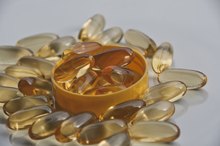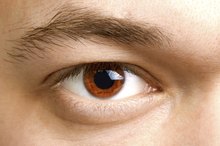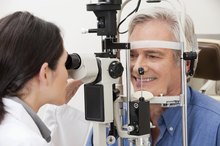Foods to Help Prevent Cataracts
A cataract is the clouding of your eye's natural lens, which leads to loss of vision. Age-related cataracts are a common cause of blindness. The exact cause of a cataract is unclear, but experts suggest oxidation caused by free radicals damages proteins and enzymes in the eye's lens. Surgery is the conventional treatment for cataracts. Regularly including certain foods in your diet may help reduce the risk of cataracts or slow their progression, says All About Vision 2.
Vitamin C
Antioxidants protect cells from free radicals, unstable molecules which damage healthy cells. There is some evidence higher intakes of the antioxidant vitamin C decreases the risk of cataracts, slows their progression and reduces the need for cataract surgery. Consuming at least 250 mg of vitamin C daily may be beneficial to eye health, reports the American Optometric Association. Five servings of well-chosen fruits and vegetables can provide 100 mg or more vitamin C. Good sources of vitamin C include:
- oranges
- grapefruit
- papaya
- cantaloupe
- green peppers
- tomatoes
- strawberries
- broccoli
- Antioxidants protect cells from free radicals, unstable molecules which damage healthy cells.
- There is some evidence higher intakes of the antioxidant vitamin C decreases the risk of cataracts, slows their progression and reduces the need for cataract surgery.
Vitamin E
Nutrients for the Cornea
Learn More
Vitamin E is an antioxidant which may help reduce the risk of cataracts. Good sources of vitamin E include:
- wheat germ oil
- almonds
- sunflower seeds
- sunflower oil
- safflower oil
- hazelnuts
- peanuts
Vitamin E is also found in green leafy vegetables such as spinach and broccoli. The recommended dietary allowance of naturally-sourced vitamin E is 15 mg, states the Office of Dietary Supplements. Two servings of nuts and seeds daily can provide 8 to 14 mg of vitamin E, according to the American Optometric Association.
- Vitamin E is an antioxidant which may help reduce the risk of cataracts.
- Two servings of nuts and seeds daily can provide 8 to 14 mg of vitamin E, according to the American Optometric Association.
Lutein and Zeaxanthin
Lutein and zeaxanthin are antioxidant compounds known as xanthophylls, which are the yellow pigments found in plants. The pigments are also found at concentrated levels in the lenses of the eyes. Lutein and zeaxanthin may help prevent cataracts and reduce the need for cataract surgery, but it is unclear how much is required daily to protect eye health 1. The best sources of lutein and zeaxanthin include green leafy plants such as kale, spinach, collards and turnip greens. People should aim for five to nine servings of vegetables and fruits daily, according to All About Vision. Five servings of well-chosen fruits and vegetables can provide 5 to 6 mg of lutein and zeaxanthin. Consuming 6 mg of lutein and zeaxanthin daily is associated with health benefits, states the American Optometric Association 1.
Related Articles
References
- All About Vision: Lutein and Zeaxanthin: Eye and Vision Benefits
- All About Vision: Can a Healthy Diet Prevent Cataracts?
- American Macular Degeneration Foundation. What is macular degeneration? Updated 2019.
- American Optometric Association. Lutein & Zeaxanthin.
- Yadav UC, Kalariya NM, Ramana KV. Emerging role of antioxidants in the protection of uveitis complications. Curr Med Chem. 2011;18(6):931–942. doi:10.2174/092986711794927694
- Hu BJ, Hu YN, Lin S, Ma WJ, Li XR. Application of Lutein and Zeaxanthin in nonproliferative diabetic retinopathy. Int J Ophthalmol. 2011;4(3):303–306. doi:10.3980/j.issn.2222-3959.2011.03.19
- The Age-Related Eye Disease Study 2 (AREDS2) Research Group. Lutein + zeaxanthin and omega-3 fatty acids for age-related macular degeneration: the Age-Related Eye Disease Study 2 (AREDS2) randomized clinical trial. JAMA. 2013;309(19):2005-15. doi:10.1001/jama.2013.4997
- Juturu V, Bowman JP, Deshpande J. Overall skin tone and skin-lightening-improving effects with oral supplementation of lutein and zeaxanthin isomers: a double-blind, placebo-controlled clinical trial. Clin Cosmet Investig Dermatol. 2016;9:325–332. Published 2016 Oct 7. doi:10.2147/CCID.S115519
- Abdel-Aal el-SM, Akhtar H, Zaheer K, Ali R. Dietary sources of lutein and zeaxanthin carotenoids and their role in eye health. Nutrients. 2013;5(4):1169–1185. Published 2013 Apr 9. doi:10.3390/nu5041169
- Ma L, Dou HL, Wu YQ, et al. Lutein and zeaxanthin intake and the risk of age-related macular degeneration: a systematic review and meta-analysis. Br J Nutr. 2012;107(3):350-9. doi:10.1017/S0007114511004260
- Richer S, Newman S. Diet and Nutrition. Alabama Optometric Association (ALOA), 2019.
- The Age-Related Eye Disease Study 2 (AREDS2) Research Group. Lutein + zeaxanthin and omega-3 fatty acids for age-related macular degeneration: the Age-Related Eye Disease Study 2 (AREDS2) randomized clinical trial. JAMA. 2013;309(19):2005-15. doi:10.1001/jama.2013.4997
- Torrey, George, PhD. Zeaxanthin for Preventing Macular Degeneration. American Macular Degeneration Foundation. October 2018.
Writer Bio
Based in southeast England, Sharon Kirby has been writing health-related articles since 2005. Her work has appeared in "Nursing Times" magazine, "Issues" magazine and The Online Journal of Sport Psychology. Kirby's education includes a Master of Science in sports science and a Bachelor of Science in psychology from Essex University.








